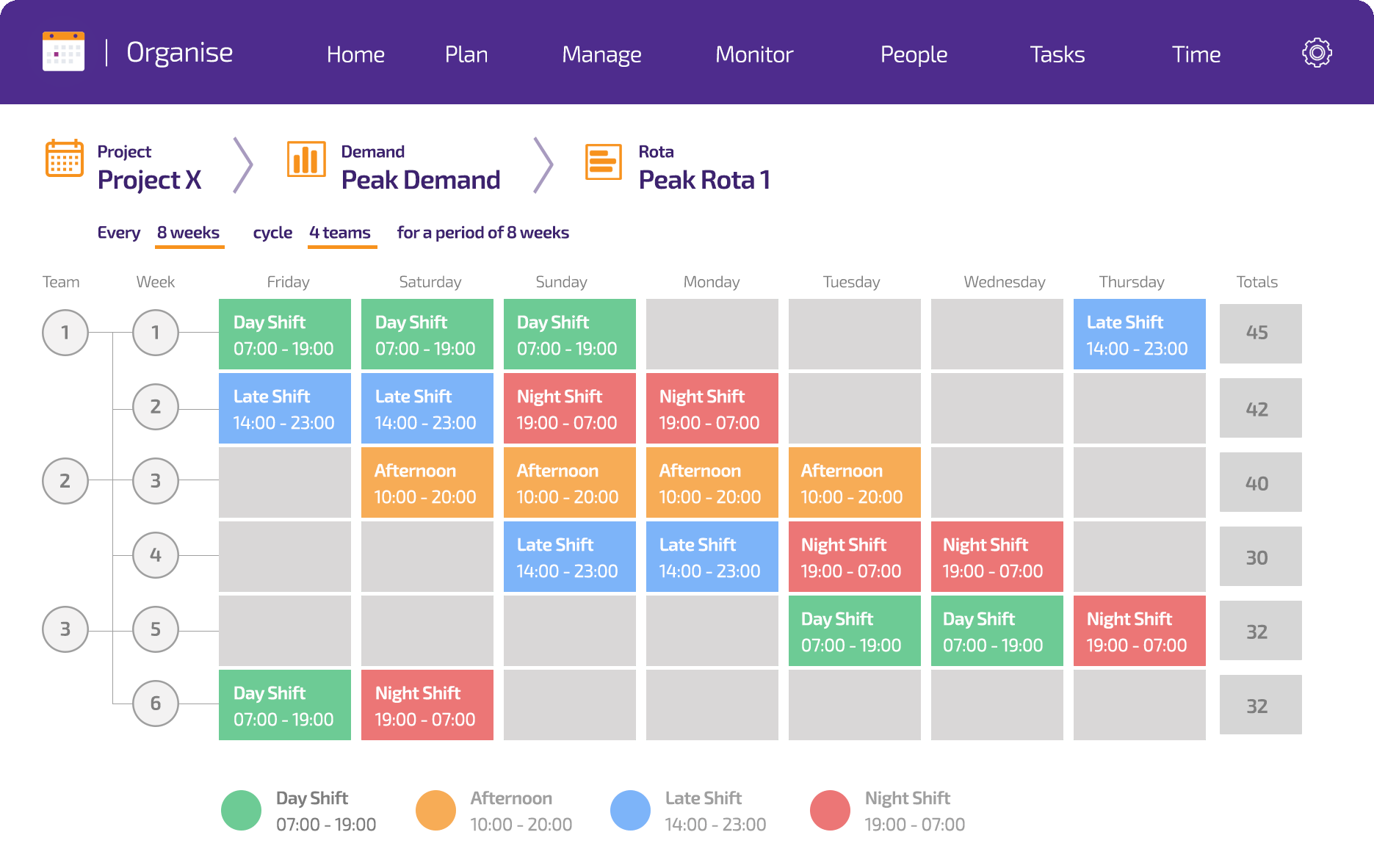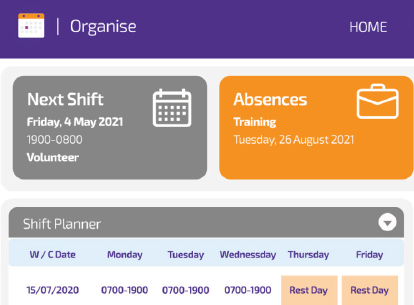Planning shift work in a crisis
Shift patterns, rotas and workforce rostering
The crisis triggered by the Coronavirus (COVID-19) pandemic is impacting industries and organisations very differently.
The change in demand profiles, high absence rates and compliance with social distancing rules requires significant changes to shift patterns, rotas and rosters.
We want to share some of our insight around how workforce planning and management can help your organisation adjust to both the immediate crisis and the uncertain future we all face.

This article is based on our recent webinar where two members of our senior team provided advice on adapting shift patterns, rotas and rosters to support employee wellbeing and operational capacity during the Coronavirus (COVID-19) pandemic.
Whilst this contains advice around key steps and example patterns, it is a broad and condensed overview.
If you want to discuss your specific situation confidentially with one of our experts, please book a remote 1-2-1 session.
Key takeaways from this article include:
Ensure you have a workable, manageable approach
- Meet demand in line with current constraints around Coronavirus (COVID-19).
- Remain responsive to changes in supply and demand.
- Monitor workforce activity and working time regulations.
- Plan for phased lifting of restrictions and return to ‘business as usual’.
Look after your workforce and communicate throughout
- Focus on employee health and wellbeing and consider the impact of changes on pay/conditions.
- Use innovative approaches to involve, engage and collaborate with employees where possible.
- Consider Health and Safety Executive best practice (HSG 256) and fatigue and risk.
Deliver Demand-Led Rostering
- Understand what options are desirable and feasible.
- Adapt shift patterns, rotas and rosters to optimise resources and maximise cover.
- Consider changing schedules and team structures to meet social distancing guidelines.
Understand ‘true’ demand & key supply factors
- How has your demand changed?
- What do you need your workforce to do at this time?
- What is your critical staffing level?
- How much labour is available?
- What adaptations need to be made?

A proven approach for a new reality
For nearly 30 years Totalmobile has focused on overcoming workforce planning and management challenges in shift working environments…from improving productivity and efficiency to maintaining compliance with working time regulations and supporting the wellbeing of shift workers.
Many of these underlying issues can be alleviated or resolved by aligning shift patterns, rotas and rosters as closely as possible to the service or operational requirements of the organisation.
The dynamics created by Coronavirus (COVID-19) has created a sudden and significant range of operational and workforce issues that can be addressed through a better balance between labour supply and demand. These include:
- Supporting the health and wellbeing of employees both in terms of managing the additional threat posed by Coronavirus (COVID-19) and the hours they are working.
- Meeting core demand efficiently and effectively.
- Maintaining output or service levels against a backdrop of reduced supply of labour and skills due to illness or self-isolation.
- Incorporating new factors around social distancing, enhanced hygiene protocols or additional workforce resilience.
While short term adjustments need to be made to shift patterns, rotas and rosters to overcome these immediate challenges, a phased return to ‘business as usual’ will also require a level of flexibility that places a sustained focus on shift work planning and management.
By gaining better visibility and control over the fundamentals, organisations will be in a better position to navigate the changing landscape…anticipating and responding to volatility in demand and factors influencing the supply of labour.
However, it’s crucial that employee wellbeing, communication and engagement remain at the heart of your approach to shift work planning, as co-creating solutions with your workforce will further enhance responsiveness and lead to better outcomes.
Totalmobile has adapted our proven methodology to respond to the challenges posed by Coronavirus (COVID-19).
Contact us to gain remote access to our specialist consultancy and workforce planning and management software so you can align labour supply and demand over the short and medium term.
Arrange a session with one of our experts where you can discuss the challenges you face and talk in broad terms about potential solutions and next steps.
Step 1 – Business evaluation: Critical demand
Understanding critical demand is the first practical measure organisations can take when adapting shift patterns, rotas and rosters to meet the challenges posed by Coronavirus (COVID-19).
Taking time to identify what your critical demand is will ultimately influence what temporary shift working measures you can introduce quickly and safely.
Ask yourself:

What makes up demand?
- What are the constituent parts of your overall demand?
- How much is planned Vs. reactive or emergency?
- How is Coronavirus (COVID-19) directly impacting the demand you need to meet?
- Can you scenario model how this might evolve over time?
- What capacity constraints are you facing/likely to face?
What about your workforce?
- What is the minimal staffing level and skills for key tasks and certain demand levels?
- Have you identified key skill groups?
- Can you manipulate your workload in some way?
- Would it be possible to make necessary changes within existing employment contract terms and conditions?
Is there an opportunity to re-organise?
- Can all non-essential or planned work be halted to free up workforce capacity?
- What is the best time to do this work (can it be brought forward or pushed out)?
- Is it possible to re-phase demand?
- Can your demand curve be smoothed out to remove unnecessary peaks and avoid the additional pressure this creates?
What do we need to do?
- What is your true operational demand right now?
- How much of it is operationally critical?
- What is essential work?
- Have you challenged yourself around which elements are truly vital?
- Which areas may be influenced by changing restrictions or other external factors?
Now more than ever it’s imperative that you meet actual organisational demand in the most efficient and effective way possible. Understanding the constituent parts of overall demand and what has to be done right now to keep critical services going is key.
To help customers during this difficult period Totalmobile’s consultants are providing remote demand data analysis and modelling support as well as a ‘fast track’ methodology which helps organisations with limited demand and supply data.
We’re also helping maintain demand models and scenarios so that organisations can continuously adapt their shift patterns, rotas and rosters in line with the latest information.
Contact us if you’d like to know more.

Step 2 – Business evaluation: Labour supply
Understanding labour supply dynamics is the next practical measure when responding to Coronavirus (COVID-19) shift work planning challenges. There are many distinct industry and organisation-level factors that affect labour availability.
Some of these have been exacerbated by this crisis but there are also a range of additional considerations specific to the health challenge posted by the pandemic. To align labour supply and demand it’s vital you explore in detail how much availability there is in your workforce.
Ask yourself:
Have we got a handle on the basics?
- Is true net availability understood in detail (factoring in annual contractual hours, holidays, training etc)?
- Can you accurately calculate how many hours people have worked over any given period?
How are absence rates effected?
- What proportion of the workforce are ill or self-isolating?
- Can you quickly identify what impact it is having on availability of certain roles/key skills and what interdependencies need to be considered?
How about working practices?
- Does site capacity impact how many people can be on shift at any one time?
- How can social distancing be maintained in areas/times of high footfall such as clocking in or breaks?
- Do you need to re-structure key teams to build in a level of resilience and flexibility around skills and supervision?
Now more than ever it’s imperative that you meet actual organisational demand in the most efficient and effective way possible. Understanding the constituent parts of overall demand and what has to be done right now to keep critical services going is key.
To help customers during this difficult period Totalmobile’s consultants are providing remote demand data analysis and modelling support as well as a ‘fast track’ methodology which helps organisations with limited demand and supply data.
We’re also helping maintain demand models and scenarios so that organisations can continuously adapt their shift patterns, rotas and rosters in line with the latest information.
Contact us if you’d like to know more.
Step 3 – Designing interim shift patterns, rotas and rosters
Once you understand labour demand and supply in detail, there’s an almost infinite range of potential options available to address your specific workforce planning and management challenges.
There may be some fairly simple adjustments that can be made to shift patterns, rotas and rosters that have an immediate positive impact on the organisation and employees.
Before looking at specific solutions, ask yourself:

- Where can you maximise contractual flexibility – what options does this rule in or out?
- Can you stagger start and finish times to reduce the maximum number of people on site or in specific locations within your workplace at any one time?
- Can team handover protocols be modified so can they be conducted remotely from separate rooms? Would this require additional time to be factored in?
- Should you off-set breaks so employees do not congregate in shared spaces? What knock on effect would this have on other aspects such as catering?
- Would it be sensible to split out key skill groups across different rosters to reduce the risk of disruption caused by absence in this cohort? Can you consider teamed rosters for multiple skill groups so the same people stay together whilst minimising their contact with others?
- Can the number of team handovers within a roster be minimised (e.g. Keep Team 1 with Team 3 and Team 2 with Team 4 etc) to minimise risk?
- Could any over-cover (within teamed structures) be re-distributed across other teams?
- Would introducing temporary work arrangements help maximise the use of key assets and consequently increase your capacity? If so, you could consider temporary patterns for certain areas of operations.
- Could capacity be expanded by spreading key skills across more teams or across revised geographical areas?
- Is there the potential to introduce temporary arrangements based on alternative team structures? For example, in the event of a drop in demand, rather than moving from 3 teams down to 2 teams, could a 2.5 team structure meet requirements?
- How do we effectively transition into and out of the interim arrangements?
Most of these adaptations rely on proven Demand-Led Rostering techniques which will ensure that an organisation operates within critical staffing levels whilst maintaining a focus on employee health and wellbeing. The algorithms in Totalmobile’s unique shift pattern design software can help you model the best shift patterns, rotas and rosters to meet evolving labour demand and supply.
Below are a few simple illustrative examples of shift patterns that could support your response to Coronavirus (COVID-19).
We’ve created a remote mechanism to ensure you and your colleagues can remotely collaborate with our experts, using the software to model and shortlist options in a real-time environment.
Contact us if you’d like to know more.
Arrange a session with one of our experts where you can discuss the challenges you face and talk in broad terms about potential solutions and next steps.

Example shift patterns
Supporting social distancing within shift working environments
These shift pattern examples will help organisations comply with social-distancing guidelines:
Example shift pattern 1:
- This shift pattern delivers a significant reduction in interactions and overlap.
- It’s based on a 24/7 pattern with 12-hour shifts.
- A ‘traditional’ 4 team structure is split down into 8 smaller teams to minimise contact.
- Pairing of teams will further reduce risk (Team 1 and 5 work opposite each other, as do Teams 2 & 6).
- The new shift pattern runs over an 8-week cycle instead of 4 to meet demand.
- A stagger of 30 minutes is factored in to ensure different start times/briefings and reduce footfall at changeover/breaks etc.
Example shift pattern 2:
- This shift pattern meets demand but reduces contact.
- It’s based on a double day shift pattern working early and late shifts in rotation over a two-week cycle.
- The new shift pattern spreads the required hours over a full week.
- It also introduces night shifts and splits 2 teams into 4 to reduce the number of assets being run, and therefore the number of people onsite at any one time.
- Health and wellbeing must be considered around the introduction of night shift and weekend working.
Optimising resources to deal with unplanned absences within shift working environments
These shift pattern examples will help organisations deliver the same workload with fewer people:
Example shift pattern 3:
- This shift pattern maximises the amount of cover from skeleton crews.
- It’s based on an adaption of a traditional 4 crew, 12-hour pattern delivering 36 hours per week across a 4-week cycle.
- The new shift pattern utilises ‘half-team’ structures to cover the same number of hours with less people.
- The same demand is covered by 3.5 teams now averaging 41.1 hours per week (well within working time regulations).
- On each shift two half-teams are rostered to provide the same cover.
- The skills mix needs to be considered given the re-structuring of teams.
Example shift pattern 4:
- This shift pattern reduces the risk of unavailability in an on-call environment.
- It’s based on an adaption of a traditional ‘on-call’ arrangement where 12:00-18:00 shifts are followed by periods of on-call, but with the likelihood of unavailability on the Monday following the last on-call shift.
- The new shift pattern maintains the same 7 consecutive on-call shifts, but these now end on a Friday.
- The last period rolls into a rest day which helps minimise absences.
- Extending into weekends requires considerations around pay and work-life balance.
In summary
This article has briefly demonstrated how aligning supply to demand and designing optimised shift patterns, rotas and rosters can help overcome the workforce planning and management challenges created by Coronavirus (COVID-19).
We’re keen to get feedback if there is further information or topics you would like us to cover in more depth.
Likewise, contact us if you want to remotely access our specialist consultancy and shift pattern design and workforce management software.

The team at Totalmobile wishes you and your family the best at this difficult time…please take care, stay safe and look out for each other.
Arrange a session with one of our experts where you can discuss the challenges you face and talk in broad terms about potential solutions and next steps.







